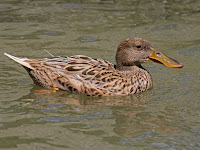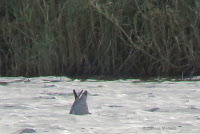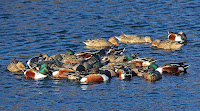NORTHERN SHOVELER
NORTHERN SHOVELER – (Spatula clypeata) – (See images below)
DESCRIPTION: The Northern Shoveler is a dabbling duck with a large, spatula-like bill. In its breeding plumage the drake has a dark green blackish iridescent head, a white breast and rufus sides and under parts. The wings have bands of blue, white and green. The female is similar to a mallard female, and outside the breeding season the male also looks that way. It is considered as a ‘quiet’ duck, not vocalizing frequently.
VOICE: https://www.xeno-canto.org/explore?query=northern+shoveler
NAME: This duck got its name from its bill shape. It’s also called ‘Spoonbill’ for that reason. The Latin genus name ‘Spatula’ means ‘spoon’, and the species name ‘clypeata’ means ‘shield bearing’.
HABITAT: Open wetlands.
DIET: The northern shoveler uses its large bill to filter out food such as invertebrates and plant seeds.
NESTING: Although it feeds in marshes, the northern shoveler prefers to build its nest in grassy areas.
DISTRIBUTION: Northern shovelers have healthy population levels in North America, and are almost as abundant as the Mallards. Their main breeding area in Canada is located in the western half of the country. It is also breeding in Eurasia, where it is widespread. The ducks from North America migrate mainly to the southern USA and Mexico, and those from Eurasia spend the winter in the southern part of that continent, and Africa.
DISTRIBUTION MAP: https://en.wikipedia.org/wiki/Northern_shoveler#/media/File:Anas_clypeata_distribution_map.png
ON PEI: The northern shoveler is listed as ‘uncommon to fairly common’ on Prince Edward Island, a type of classification that is due to yearly variations in observations and uneven distribution. It does breed on the island though.
ON HAWAII: Winter visitors on Hawaii, such as the ones observed at the James Campbell National Wildlife Refuge on Oahu, migrated either from Siberia or Alaska.
CONSERVATION: Northern shoveler populations appear healthy – in the few million – and this duck is regularly hunted within regulations.
SIMILAR SPECIES: The female Northern shoveler might be confused with a female Mallard.
REFERENCES: https://en.wikipedia.org/wiki/Northern_shoveler
https://www.allaboutbirds.org/guide/Northern_Shoveler/id
http://birdweb.org/birdweb/bird/northern_shoveler
https://www.audubon.org/field-guide/bird/northern-shoveler
https://www.ducks.ca/species/northern-shoveler/
http://www.nhptv.org/natureworks/northernshoveler.htm (New Hampshire PBS)
DESCRIPTION: The Northern Shoveler is a dabbling duck with a large, spatula-like bill. In its breeding plumage the drake has a dark green blackish iridescent head, a white breast and rufus sides and under parts. The wings have bands of blue, white and green. The female is similar to a mallard female, and outside the breeding season the male also looks that way. It is considered as a ‘quiet’ duck, not vocalizing frequently.
VOICE: https://www.xeno-canto.org/explore?query=northern+shoveler
NAME: This duck got its name from its bill shape. It’s also called ‘Spoonbill’ for that reason. The Latin genus name ‘Spatula’ means ‘spoon’, and the species name ‘clypeata’ means ‘shield bearing’.
HABITAT: Open wetlands.
DIET: The northern shoveler uses its large bill to filter out food such as invertebrates and plant seeds.
NESTING: Although it feeds in marshes, the northern shoveler prefers to build its nest in grassy areas.
DISTRIBUTION: Northern shovelers have healthy population levels in North America, and are almost as abundant as the Mallards. Their main breeding area in Canada is located in the western half of the country. It is also breeding in Eurasia, where it is widespread. The ducks from North America migrate mainly to the southern USA and Mexico, and those from Eurasia spend the winter in the southern part of that continent, and Africa.
DISTRIBUTION MAP: https://en.wikipedia.org/wiki/Northern_shoveler#/media/File:Anas_clypeata_distribution_map.png
ON PEI: The northern shoveler is listed as ‘uncommon to fairly common’ on Prince Edward Island, a type of classification that is due to yearly variations in observations and uneven distribution. It does breed on the island though.
ON HAWAII: Winter visitors on Hawaii, such as the ones observed at the James Campbell National Wildlife Refuge on Oahu, migrated either from Siberia or Alaska.
CONSERVATION: Northern shoveler populations appear healthy – in the few million – and this duck is regularly hunted within regulations.
SIMILAR SPECIES: The female Northern shoveler might be confused with a female Mallard.
REFERENCES: https://en.wikipedia.org/wiki/Northern_shoveler
https://www.allaboutbirds.org/guide/Northern_Shoveler/id
http://birdweb.org/birdweb/bird/northern_shoveler
https://www.audubon.org/field-guide/bird/northern-shoveler
https://www.ducks.ca/species/northern-shoveler/
http://www.nhptv.org/natureworks/northernshoveler.htm (New Hampshire PBS)
 |
| Northern shoveler with Canada goose PEI, Canada, by Richard Smith |
 |
| Northern shoveler female, Dick Daniels |
 |
| Northern shoveler diving, Oahu |
 |
| Northern shoveler male, Oahu |
 |
| Northern shoveler, by Steve Sinclair |
 |
| Northern shovelers hunting for prey |
 |
| Northern shoveler drake, by Dick Daniels |